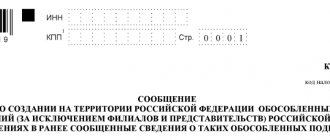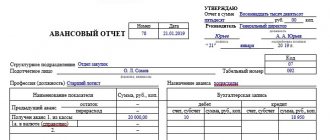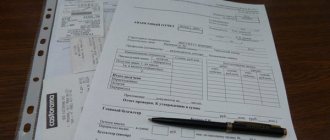The assignment of an employee to perform a labor function in another state is formalized according to the general procedure, taking into account some specific features.
For foreign business trips, the same legislative norms apply as for business trips within Russia, including paragraph 10 of the Business Travel Regulations, which establishes the obligation of the sending enterprise (organization) to bear financial coverage of all payments related to the trip.
A significant distinguishing feature of such business trips is currency waste, confirmation of which must be displayed by the employee upon arrival in the advance report and subsequently compensated by the enterprise in ruble equivalent.
What you need to know about the trip report
Upon returning from a business trip, including a foreign one, the employee is obliged to report on it and submit an advance report to the accounting department.
The form of the advance report can be approved by the local act of the company. Or, the old-fashioned way, they use a report in form AO-1.
Regardless of the form, you must comply with the deadline for submitting the report - 3 business days after the end of the business trip.
The employee attaches all documents confirming expenses to the advance report for a business trip abroad. Namely:
- travel tickets and boarding passes (if tickets are electronic, you need to print them);
- receipts for the use of bed linen;
- hotel invoices and receipts (residential rental agreement), receipts;
- receipts of fees (agent's commission for purchasing a ticket, receipt for baggage transportation, etc.);
- documents confirming payment of visa or consular fees;
- other supporting documents.
ADVICE
For the convenience of preparing and conducting an advance report, supporting documents can be pasted onto blank A4 sheets with a field for filing documents on the left.
If the employer purchases tickets and books a hotel through an agency or directly from the contractor, documents for travel and accommodation (boarding pass or voucher, hotel bill or certificate of accommodation) must be attached to the report.
Don't forget about daily allowances
The amount of daily allowance that must be paid to the employee must be approved in the local regulatory act of the organization or in the collective agreement. Let us remind you that for the purposes of “profitable” tax accounting, you can also take into account daily allowances within the limits established by the organization itself. 11 Regulations, approved. By Government Decree of 13.10.
2008 No. 749 (hereinafter referred to as Regulation No. 749); subp. 12 clause 1 art. 264 Tax Code of the Russian Federation. There is no need to accrue insurance premiums (including “for injuries”) on such daily allowances. 2 tbsp. 168 Labor Code of the Russian Federation; Part 2 Art. 9 of the Law of July 24, 2009 No. 212-FZ; clause 2 art. 20.2 of the Law of July 24, 1998 No. 125-FZ; clause 4 of the Pension Fund Letter of September 29, 2010 No. 30-21/10260; Letter of the FSS dated November 17, 2011 No. 14-03-11/08-13985.
When filling out an advance report, the expenditure of daily allowance amounts is not required to be confirmed by any documents. Letter of the Ministry of Finance dated November 11, 2011 No. 03-03-06/1/741.
But do not forget that for personal income tax purposes, maximum rates of non-taxable daily allowance have been established for each day of a business trip. 3 tbsp. 217 of the Tax Code of the Russian Federation: in Russia - 700 rubles, abroad - 2500 rubles. Daily allowances for the day of departure from Russia are calculated according to foreign standards, and for the day of arrival - according to Russian standards. 18 Regulations No. 749; Letters of the Ministry of Finance dated 09/06/2010 No. 03-04-06/6-205, dated 07/07/2010 No. 03-04-06/6-140.
If your organization pays daily allowances in larger amounts than indicated, then personal income tax must be withheld from the excess amounts. Letters from the Ministry of Finance dated 02/10/2011 No. 03-04-06/6-22, dated 07/07/2010 No. 03-04-06/6 -140.
According to the Ministry of Finance, for the purpose of paying personal income tax, daily allowances issued to an employee in foreign currency must be converted into rubles at the rate in effect on the date of their payment. Letter of the Ministry of Finance dated June 25, 2010 No. 03-04-06/6-135. Therefore, if an employee receives part of the foreign currency daily allowance before the start of a business trip, and part after returning from it, for the purpose of determining the base for personal income tax, the daily allowance will be converted into rubles at two different Central Bank rates.
Currency conversion
Let's consider a situation where an employee received an advance payment for a business trip in rubles, and the expenses were incurred in foreign currency.
An employee can independently exchange rubles for foreign currency at an exchange office in the Russian Federation or while already on a business trip abroad. In this case, the rate is taken on the date the employee purchased the currency, if he attached a certificate from the exchange office to the advance report.
It often happens that an employee cannot confirm the fact of purchasing currency. For example, due to the loss of a certificate from the bank about the completed exchange. It may also be that when exchanging currency in another country, the exchange office did not issue the employee with a conversion document.
In this case, for recalculation, they take the official exchange rate of the Central Bank on the date of approval of the advance report by the head of the company. This position is confirmed by letters from the Federal Tax Service dated March 21, 2011 No. KE-4-3/4408 and the Ministry of Finance dated March 31, 2011 No. 03-03-06/1/193.
For an example of recalculating daily allowances issued in foreign currency, see our article “Taxes and contributions on daily allowances abroad: calculation examples.”
At what rate and on what date should the currency be calculated?
The presented question is clarified by the Letter of the Federal Tax Service dated March 21, 2011, as well as the Letter of the Ministry of Finance dated March 31, 2011.
These documents explain that when financially calculating amounts for advance reports in foreign currencies, it is necessary:
- If there are documents from the bank indicating information about the exchange rate on the date the employee made the conversion, the rate indicated in the check attached to the report is used;
- In the absence of confirming bank checks - at the official rate of the Central Bank of Russia, which was in effect at the time of approval of the advance report.
You should also take into account cases where the employee exchanged funds provided by the sending enterprise (organization) in parts.
In such a situation, for more accurate calculations, several calculations should be made for each date for which there is a receipt for currency exchange, taking into account the rate noted in the corresponding receipt.
The accounting department of an enterprise (organization) should take into account that payments related to the bank's currency exchange services on foreign business trips are also subject to reimbursement (even if a reverse conversion was made in order to return the balance of the advance to the cash desk in the currency of its issue).
Deadline
When signing an order to be sent on a business trip, the employee is notified of the need to provide a report on the amounts spent to the accounting department of the sending enterprise (organization) within three working days from the date of return from the business trip.
The presented period is established not by the legal entity itself where the posted worker is officially employed, but by the Bank of Russia in its Directive No. 3210-U dated March 11, 2014.
Foreign business trips in the presented issue are no exception.
It is important to note that return here should be considered the employee’s arrival at his place of permanent work, and not crossing the border of the Russian Federation.
The countdown of three days provided for the provision of an advance report begins after the date that was noted in the order of assignment as the end date of the business trip.
If an employee returns from a business trip early, as a rule, the order for premature termination of the business trip specifies the deadlines provided for submitting the corresponding report to the accounting department.
If the employee’s return from a trip coincides with the issuance of a certificate of incapacity for work, three days begin to count from the date of closure of the submitted medical certificate, since the Directive of the Bank of Russia establishes a provision on working days, and not on calendar calculation.
How to fill out Form AO-1?
Filling out the advance report for a foreign business trip should be carried out by the posted employee, however, in practice, the submitted documents are often compiled by an accountant.
It was stated above that reporting on the expenditure of funds issued to an employee for a trip abroad to perform an official assignment is provided on a unified form or on the company’s letterhead, developed for the appropriate purposes.
The advance report is completed in Russian. If there are special marks in a foreign language, they are duplicated in Russian.
All documents confirming expenses incurred (receipts for payment of accommodation, travel documents, etc.) must have an attached translation into Russian).
The full amount of expenses made by a seconded employee is recorded on the back of the unified form or in a special column reserved for the corresponding statements on the company’s letterhead.
The report should also indicate the amount of the advance, if it was made in a foreign currency (indicating its name), as well as its conversion into Russian rubles (taking into account the exchange rate in effect at the time of approval of the advance report for the corresponding business trip).
For ease of settlement, it is better to deposit all amounts in two currencies (foreign and rubles). The unified form contains a special column for such statements.
If there is no space allocated on the company’s letterhead for making relevant entries, they may be attached on a separate sheet.
Advance report
You can see how to correctly fill out an advance report for a foreign business trip here:
As a general rule, the employee must independently fill out the advance report.
In the advance report, it is important to indicate all expenses incurred by the employee during a business trip abroad.
If an employee has incurred any expenses that are not provided for in the company’s organizational and administrative document, it is necessary to attach to the report a memo with a positive resolution from the manager.
On a business trip abroad, unexpected expenses may arise - taxis, dry cleaning, expenses for cellular communications or the Internet, buying a laptop, etc., etc. Each situation must be considered separately.
You can learn about the specifics of work while constantly on business trips abroad from our article “Work related to business trips abroad: what you need to know.”
Payment of daily allowances in foreign currency according to the law
The employer himself determines in what currency he sets and pays the daily allowance for business trips abroad. For example, the amount of such daily allowance may be set in foreign currency, but the employee will receive an amount in rubles equivalent to these foreign currency daily allowances.
The Government of the Russian Federation put forward Resolution No. 812 on December 26, 2005. It regulates some aspects of the issuance and amount of daily payments in foreign currencies. According to it, daily allowances have been established for employees of budgetary organizations arriving in certain countries.
Foreign business trip: how to calculate daily allowance
Calculation of daily allowances for business trips abroad in 2018-2019. depends on the number of days spent by the employee outside the Russian Federation.
As a general rule, daily allowances are paid to an employee as follows (clauses 17, 18 of the Regulations, approved by Decree of the Government of the Russian Federation of October 13, 2008 No. 749):
- when going on a business trip abroad, the daily allowance for the day of crossing the border is paid as for the time spent abroad;
- when returning from a trip abroad, per diem for the day of crossing the border is paid as for a business trip within the country.
True, the company has the right to establish its own procedure for calculating daily allowances paid.
The entire amount of daily allowance (without any restrictions) can be taken into account as expenses when determining the income tax base (clause 12, clause 1, article 264 of the Tax Code of the Russian Federation).
If daily allowances are issued in rubles, then accounting for such expenses will not cause any difficulties - simply the entire amount is written off as part of “profitable” expenses.
The amount received is included in expenses.
When traveling abroad, personal income tax is not imposed on the amount of daily allowance not exceeding 2,500 rubles. per day (clause 3 of article 217 of the Tax Code of the Russian Federation). Accordingly, personal income tax must be withheld from the amount above this limit and transferred to the budget.
By the way, if the daily allowance in an organization is set in foreign currency, but is paid to the employee in rubles, then no recalculations need to be made (Letters of the Ministry of Finance dated 04/22/2016 No. 03-04-06/23252, dated 02/09/2016 No. 03-04-06/ 6531).
As a general rule, daily allowances paid to employees in 2018-2019 are subject to insurance contributions on the same principle as personal income tax. That is, contributions must be calculated from the amount of daily allowance exceeding 2,500 rubles (clause 2 of Article 422 of the Tax Code of the Russian Federation).
What are the rules for traveling abroad?
The Russian government has approved Resolution No. 812, which determines daily allowance standards for trips to foreign countries. It is mandatory for all organizations and institutions, the source of financing expenses in which the budget of the country or municipalities is.
This defines per diem rates expressed in US dollars for each foreign host country for one day.
Let's consider the main directions of business trips abroad:
| Foreign country - place of business trip | Daily allowance expressed in US dollars |
| Great Britain | 69 |
| Germany | 65 |
| China | 67 |
| Türkiye | 64 |
| USA | 72 |
Attention! In addition, this act also establishes allowances to the standards for certain categories of workers sent on foreign trips. Commercial companies can use the standards of this Resolution, or apply their own standards developed on its basis.
Download daily allowance rates for business trips abroad (Appendix No. 1) in Word format.
You might be interested in:
Is it possible to refuse a business trip - in what case is this possible, the consequences of an unreasonable refusal
Download the amounts of allowances for a foreign trip (Appendix No. 2) in Wod format.
Results
Despite the apparent complexity of calculating daily allowances for business trips abroad, usually accountants quickly get the hang of it and make virtually no mistakes.
The main thing is to correctly fix the required payment rates, correctly calculate the amounts to be issued and accurately maintain documentation. In this case, the tax authorities will have nothing to complain about. You can find more complete information on the topic in ConsultantPlus. Free trial access to the system for 2 days.
We learn to draw up expense reports using examples (1C: Accounting 8.3, edition 3.0)
Lessons on 1C Accounting 8 >> Bank and cash desk
2016-12-08T12:30:37+00:00
| Is the article outdated and in need of revision? |
In my observation, for novice accountants, preparing expense reports is a significant challenge at first.
Today we will look at the basics of this matter, as well as the most popular cases from life. We will perform all experiments in 1C: Accounting 8.3 (edition 3.0).
So, let's begin
It’s not for me to tell you that 71 accounts are responsible for settlements with accountable persons in the accounting department:
The issuance of assets is reflected to the employee as a debit to this account, and write-offs are reflected as a credit.
Well, for example, they gave out 5000 against a report from the cash register:
| Dt 71 Kt 50 5000 |
The employee reported on the use of these funds, for example, to pay for general business expenses... well, for example, for electricity:
| Dt 26 Kt 71 5000 |
Why did I say assets ? This is because we can give the employee:
- Cash (from the cash register through cash register)
- Non-cash funds (transfer from the organization's current account to the employee's card account)
- Financial documents (for example, plane tickets for a business trip)
Let's look at each of the examples listed above.








